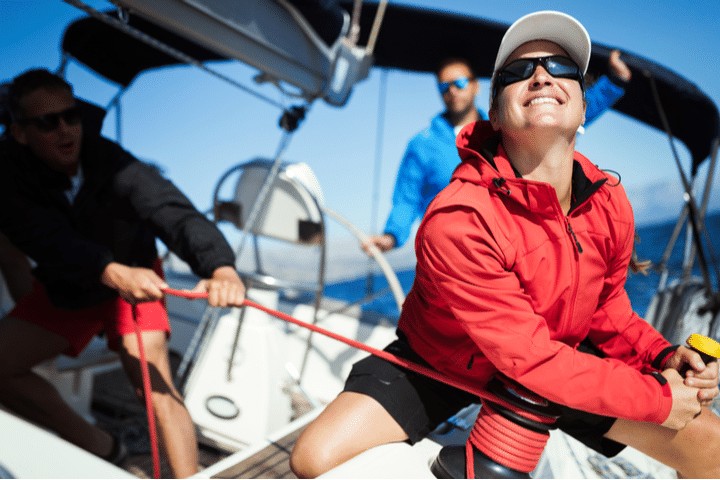Sailing, a captivating blend of skill, strategy, and freedom, has beckoned adventurers for centuries. The thought of gliding across the water, propelled by the wind, is a dream shared by many. While mastering the art of sailing requires dedication and experience, getting started is surprisingly accessible. This beginner’s guide to sailing will provide you with the foundational knowledge to embark on your nautical journey, from understanding basic terminology to practical tips for your first voyage. Forget years of intensive training; let’s get you sailing!
Sailing offers a unique experience, a luxurious hobby that provides the freedom and flexibility that many sailboat owners seek. While renting or chartering a boat provides a temporary taste of the sailor’s life, owning your own boat opens up a world of possibilities. This guide provides essential information, serving as a gateway to grand adventures at sea.
Essential Sailing Vocabulary
Navigating the world of sailing requires understanding its unique language. Clear communication on the water is critical, and familiarity with common terms is the first step. As you gain experience, you’ll expand your sailing vocabulary. Here are some key terms to get you started:
Aft: The rear of the boat. Anything located towards the back is considered “aft.” Also known as the stern.
Boom: The horizontal spar attached to the foot of the mainsail. It plays a vital role in controlling the sail’s shape and harnessing wind power. Understanding how to adjust the boom is critical to efficient sailing.
Bow: The front of the boat. Anything in the front section is referred to as “forward.”
Helm: The steering mechanism of the boat, usually a wheel on most sailboats.
Heeling: The tilting of the boat caused by wind pressure on the sails. A controlled amount of heeling is normal and can improve sailing performance.
Jib: A smaller sail set forward of the mast. The jib helps with steering and overall sail balance.
Keel: A fin-like structure extending below the hull. The keel provides stability and prevents the boat from capsizing.
Leeward: The direction away from the wind or the side of the boat sheltered from the wind. The low side of the boat when heeling.
Lines: Ropes used for controlling the sails and other equipment on the boat.
Mainsail: The primary and largest sail, attached to the mast and boom. The mainsail is the engine that propels the boat forward.
Port: The left side of the boat when facing forward.
Starboard: The right side of the boat when facing forward.
Tacking: Changing direction by turning the bow of the boat through the wind. Efficient tacking is a key skill for sailing upwind.
Windward: The direction from which the wind is blowing, or the side of the boat facing the wind.
Essential Preparations
While the image of a carefree sailing adventure is appealing, your initial voyages will likely involve a learning curve. Prior preparation is key to ensuring comfort and safety. Essential items include a waterproof jacket, non-slip shoes, sunscreen, and a properly fitting life jacket for everyone on board. Remember to check the expiration dates on fire extinguishers.
Before setting sail, always check the weather forecast. While strong winds can be exhilarating, they can also be dangerous for inexperienced sailors. Aim for calmer conditions for your first few outings. Consult a reliable weather source specializing in marine forecasts.
A common hazard for new sailors is being struck by the boom. Developing awareness and quick reflexes to avoid the swinging boom is crucial.
Understanding the Rules of the Waterway
Adhering to maritime rules is paramount for safety. Imagine driving a car without knowing traffic laws – the same chaos applies to sailing. Ignorance of the rules can lead to dangerous situations. It can be quite alarming when another boat is headed your way, and you’re unsure of right-of-way.
Familiarize yourself with basic boating regulations through online resources. Additionally, each state has its own specific rules and regulations; ensure you are aware of those pertaining to both navigation and sailboat ownership and registration.
Getting Started: Practical Experience
While reading about sailing is valuable, hands-on experience is essential.
Take a Sailing Course: A hands-on sailing course led by qualified instructors provides invaluable practical experience. These courses offer structured learning and the opportunity to sail with others.
Sail with Experienced Friends: If you know someone who sails, ask if you can join them. Learning from an experienced sailor is a great way to build your skills.
Rent a Boat with a Captain: Renting a boat with a captain is a low-pressure way to experience sailing. This can also help you determine which type of sailboat you might want to buy in the future.
Practice Makes Perfect
The next step is to practice regularly. Avoid the temptation to immediately embark on challenging voyages. Start by familiarizing yourself with your boat in a controlled environment.
If possible, rent a boat that is smaller and easier to handle than your own. This can significantly improve your confidence when transitioning to a larger vessel.
Bring an experienced sailor along on your first few outings. They can provide guidance and identify potential issues.
Choose a less crowded area for practicing. This allows you to focus on learning without the added stress of navigating around other boats.
Practice in ideal weather conditions to concentrate on technique.
Use this time to learn the “points of sail,” which dictate the boat’s direction and speed relative to the wind. Mastering these points is crucial for maneuvering and responding to changing conditions.
Advanced Drills
Once you’re comfortable with the basics, introduce more challenging scenarios to refine your skills.
Practice sailing in choppy waters and during wind gusts with an experienced sailor onboard. Learn how to handle these conditions safely and effectively.
Practice navigating in crowded waters. Having a seasoned sailor assist you through busy waterways will build your confidence and skill.
Setting Sail on Your Own
Most sailors develop a sense of when they are ready to sail independently. However, having an experienced sailor onboard is always recommended in case of an emergency.
Develop a plan for emergencies, such as a fire or capsize. Familiarize yourself with the location of safety equipment and emergency procedures specific to your boat and region. Having a medical kit and CPR knowledge is also crucial.
Practice emergency drills, such as intentionally capsizing the boat to prepare for the worst-case scenario, or practicing rescuing someone who has fallen overboard. Know the correct procedures for handling boating emergencies.
As a responsible boat owner, prioritize environmental protection. Be aware of potential pollutants, such as fuel and oil leaks, and follow best practices for greywater disposal. Familiarize yourself with eco-friendly boating practices.
Embrace the Journey
Mastering sailing takes time and dedication. Each voyage offers opportunities to learn and experience something new. Connect with other sailboat owners to share knowledge and learn “tricks of the trade.”
Sailing offers a unique sense of freedom and exhilaration. For many, owning a sailboat represents a lifestyle, with the pleasure of relaxing on deck with friends as the sun sets over the ocean. Embrace the journey and enjoy the finer things in life that sailing provides.

